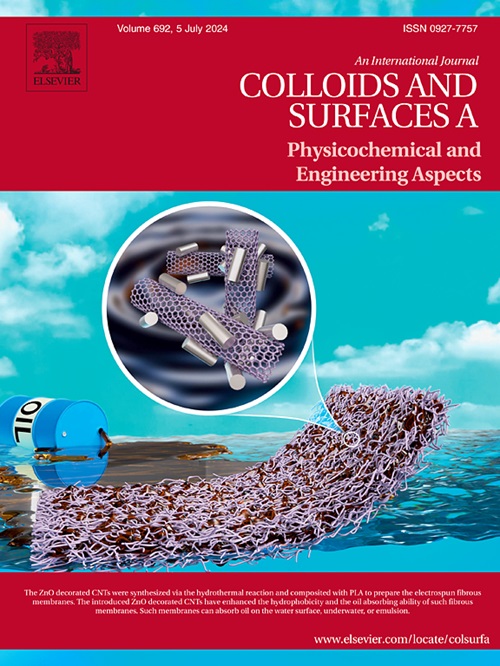Pd改性HfTe2单层膜的第一性原理研究:变压器油中溶解气体的检测
IF 5.4
2区 化学
Q2 CHEMISTRY, PHYSICAL
Colloids and Surfaces A: Physicochemical and Engineering Aspects
Pub Date : 2025-07-17
DOI:10.1016/j.colsurfa.2025.137782
引用次数: 0
摘要
检测油浸式变压器绝缘油中的故障特征气体对电力系统的稳定运行具有重要意义。在这项工作中,基于第一性原理计算,我们构建了原始的HfTe2和Pd修饰的HfTe2结构。通过几何优化,建立了纯HfTe2和Pd-HfTe2表面对CO、CO2、CH4、C2H2、C2H4和H2气体分子的12种吸附构型。从吸附能、态密度、电子密度、前沿分子轨道理论、灵敏度、恢复时间、功函数等多个角度深入研究了这些吸附体系的吸附特性和气敏过程。结果表明,Pd-HfTe2显著提高了对CO、CO2和C2H4的吸附性能,吸附能分别达到- 1.425 eV、- 0.786 eV和- 0.816 eV。此外,在298 K下,CO2和C2H4的回收时间分别为19.22 s和63.20 s,表明这些气体可以在室温下从Pd-HfTe2表面快速解吸。与其他二维材料相比,Pd-HfTe2有望成为检测CO2、C2H4等特征气体的低功耗气体传感器和清洁CO气体的固体吸附剂材料。本研究的模拟结果为构建能够检测油中溶解特征气体的HfTe2传感器提供了理论建议。本文章由计算机程序翻译,如有差异,请以英文原文为准。
First-principles investigation of Pd modified HfTe2 monolayer membranes: Detection of dissolved gas in transformer oil
Detecting the fault characteristic gases in insulating oil of oil-immersed transformers is of significant importance for the stable operation of power systems. In this work, based on first-principles calculations, we constructed pristine HfTe2 and Pd modified HfTe2 structures. Twelve adsorption configurations for CO, CO2, CH4, C2H2, C2H4, and H2 gas molecules on the surfaces of pure HfTe2 and Pd-HfTe2 were developed by means of geometry optimization. From a number of angles, including adsorption energy, density of states, electron density, frontier molecular orbital theory, sensitivity, recovery time, and work function, we thoroughly investigated the adsorption characteristics and gas-sensing processes of these adsorption systems. The results demonstrate that Pd-HfTe2 significantly enhances the adsorption performance for CO, CO2, and C2H4, with adsorption energies reaching −1.425 eV, −0.786 eV, and −0.816 eV, respectively. Furthermore, the recovery times for CO2 and C2H4 at 298 K are 19.22 s and 63.20 s, indicating that these gases can be rapidly desorbed from the Pd-HfTe2 surface at room temperature. Compared with other two-dimensional materials, Pd-HfTe2 holds promise as a low-power gas sensor for detecting characteristic gases like CO2 and C2H4 and as a solid adsorbent material for cleaning CO gas. Theoretical advice for the construction of HfTe2 sensors that can detect dissolved characteristic gases in oil is provided by the simulation results described in this study.
求助全文
通过发布文献求助,成功后即可免费获取论文全文。
去求助
来源期刊
CiteScore
8.70
自引率
9.60%
发文量
2421
审稿时长
56 days
期刊介绍:
Colloids and Surfaces A: Physicochemical and Engineering Aspects is an international journal devoted to the science underlying applications of colloids and interfacial phenomena.
The journal aims at publishing high quality research papers featuring new materials or new insights into the role of colloid and interface science in (for example) food, energy, minerals processing, pharmaceuticals or the environment.

 求助内容:
求助内容: 应助结果提醒方式:
应助结果提醒方式:


